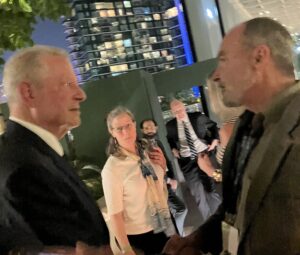By SGA Executive Director, Gary Cuneen
COP28 – Day 6
Let’s start by addressing COP28 President Al Jaber’s comment that phasing out fossil fuels is fine if people want to “go back to living in caves”. Aside from the immaturity of such a public comment for a person in his position, at least the lines are drawn and out in the open. There of course is strong opposition to this – including from the UN – and Al Jaber’s stance is that there is no scientific basis or data to justify the position of phasing out fossil fuels. My push back on his comment is that there is no science-based justification or strategy roadmap that he has articulated to justify his position – which at the very least falls in the category of the pot calling the kettle black and even more is egregiously irresponsible in light of the extreme data by the IPCC outlining how close we are to breaking 1.5 degrees Celsius and entering into unchartered irreversible climate and ecosystem damage. (See a video clip above of former Vice President Al Gore also speaking to these issues)
I visited the Energy Transition and Technology Hubs today in the COP28 “Green Zone” and asked direct questions at a Carbon Air Capture model display area related to the lack of scalability of this technology to have significant impact. The west Texas model plant – yet to be built – is anticipated to remove 500,000 tons annually of carbon in comparison to the 37 gigatons of carbon that exists currently. While I am not opposed at all to new tech development and the need to experiment with multiple solutions (including small nuclear reactors), this technology is unproven on a large scale and many see it as a trojan horse for the position against phasing out fossil fuels.
Another technology which I had never heard of (and I’ve heard of green hydrogen; new steel processing not using coal; air carbon capture; aviation biofuels and hydrogen; solar floating PVs; small nuclear reactors; AI and satellite ghg tracking; and others) is the use of combined electromagnetic discs through “bandwagoning” to generate compact energy that according to well-financed industry advocates is much more efficient than solar and much more compact. The science sounds viable, but it is still an “emerging” technology that will either fade away or gain traction.

I mentioned in a previous post the amazing work of Al Gore’s Climate Trace initiative, which essentially uses satellite and AI to track emissions on local facility, sector, state and country levels. Last year I asked Mr. Gore why Climate Trace hasn’t been officially adopted by the UN (since tracking and reporting is a miserable embarrassment to the whole COP process), and he said they were working on it. When I asked him and his co-lead Gavin McCormick a few days ago the same question, Mr. Gore repeated his answer while Mr. McCormick stated that Climate Trace wanted to remain totally independent from the UN. Yesterday at the US Center, a Biden Administration new initiative called the US GHG Center (EPA, NASA, NOAA and NIST) was launched, and will include US ghg emissions tracking and will play the role of assisting other countries in doing the same. Seems quite similar to Climate Trace. Stay tuned.
